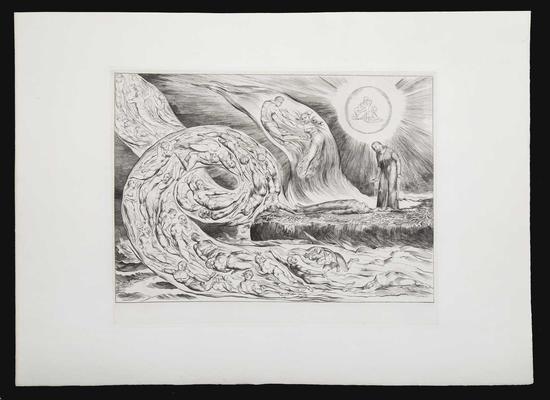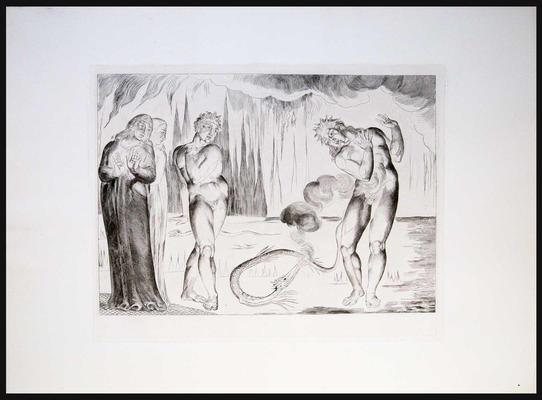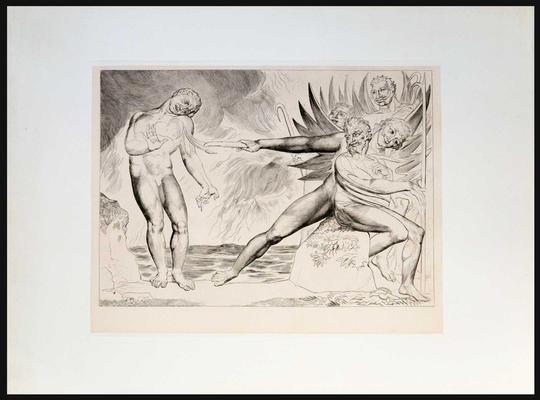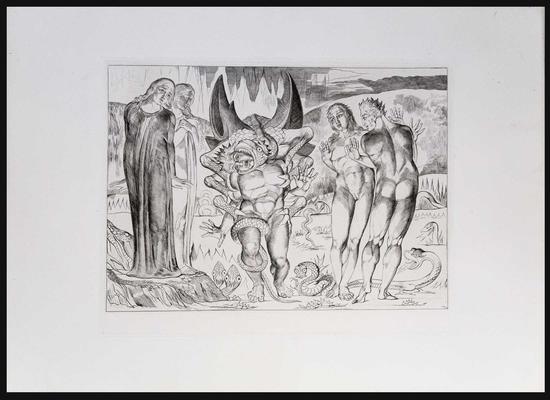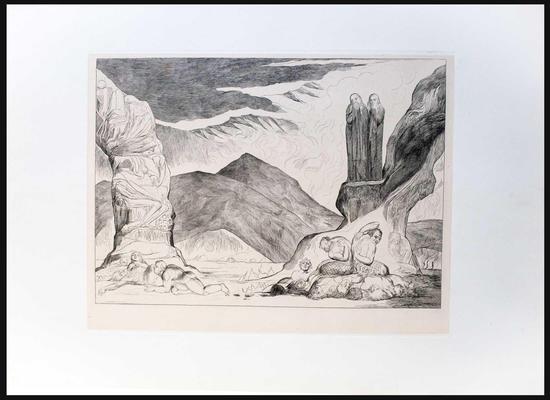William Blake
Illustrations of Dante. Seven Plates, designed and engraved by William Blake. Author of “Illustrations of the Book of Job,” &c. &c.
[London, ca.1892].India-paper suite of seven line engravings (each approx. 268x345 mm, plate mark 276x356 mm), mounted on thick drawing paper (394x564 mm) and protected by tissue paper. Fragments of a watermark (italic capital N) on the backing sheet of the first two plates. Original letterpress label printed in 1838 (“Blake'sIllustrations of Dante. Seven Plates, designed and engraved by W. Blake, Author of "Illustrations of the Book of Job," &c. &c. Price £2 2s. India Paper.”) with Dante's verses as captions, taken from H. F. Cary's translation of the Commedia. Green morocco folding case, title in gilt lettering of the front board and spine, ‘Illustrations of Dante William Blake1826'.
Provenance: John Linnell (1792-1882; the owner of the original copper plates); his heirs (pencil inscriptioninside the folding case); Philip Hofer (1898-1984; the founder of the Department of Printing and Graphic Artsin the Houghton Library, Harvard); Sotheby's, New York, 14 May 1992, lot 251; Livio Ambrogio collection.
One of the very rare set of engravings made from the original copper plates in John Linnell's possession of the most significant of Blake's unfinished projects, his spiritual and artistic testament. The illustrations for the Commedia demonstrate the extraordinary power of his visionary imagination, and had been commissioned by his friend the painter John Linnell. Blake began to work in the autumn of 1824, using as his source Henry F. Cary's translation of the Commedia (probably the 1819 edition); by his death in 1827 only seven plates had been engraved and 102 designs in pencil, mostly with some colour, were in various stages of completion. The Dante copper plates became the property of Linnell, and they were first printed in 1838 – after a few proof-state impressions pulled by Blake himself during 1826-1827 – by Dickson & Ross in thirty-eight sets. A second commercial issue in fifty suites was printed in about 1892 by Holdgate for John Linnell Jr. The date of printing of the present set cannot be determined with certainty, but probably it belongs to this later issue. Inside the folding case is preserved the original cover label in letterpress, with the description of the plates, printed for the 1838 set. The suite includes the engraving of one of the most impressive and dramatic designs realised by Blake for the Commedia: The Circle of the Lustful or the Whirlwind of Lovers, depicting the touching encounter in the second circle of Hell with Francesca da Rimini and her brother-in-law Paolo Malatesta. Dante was the first to tell the story of this passionate and tragic love, saving it from oblivion. This splendid engraving, which is not faithful to Dante's text, is an example of the Romantic interest in the figure of Francesca, transforming her into a heroine. It was one of the seven Dante designs which Blake engraved during 1826-1827.
The original Blake drawings were sold in the Linnell sale at Christie's in March 1918, and are nowadays held by different museums in Britain, America, and above all by the Melbourne Gallery in Australia. The Dante copper plates have passed, with the Rosenwald Collection, to the National Gallery of Art in Washington.


